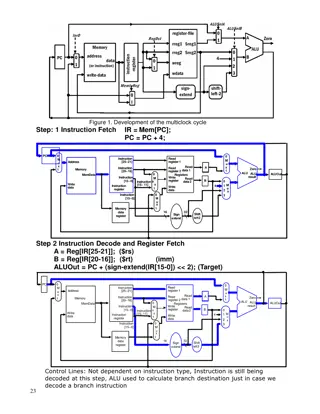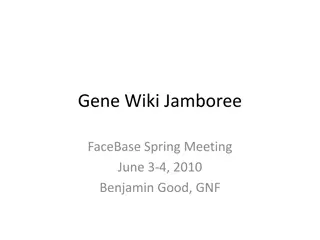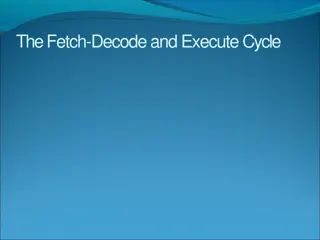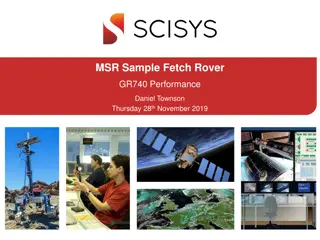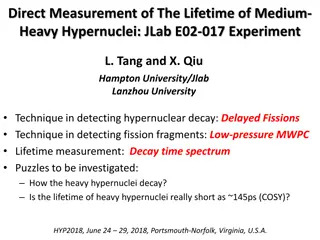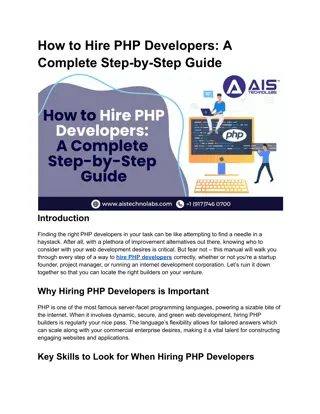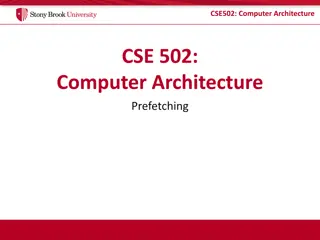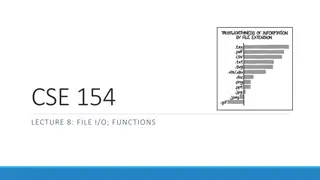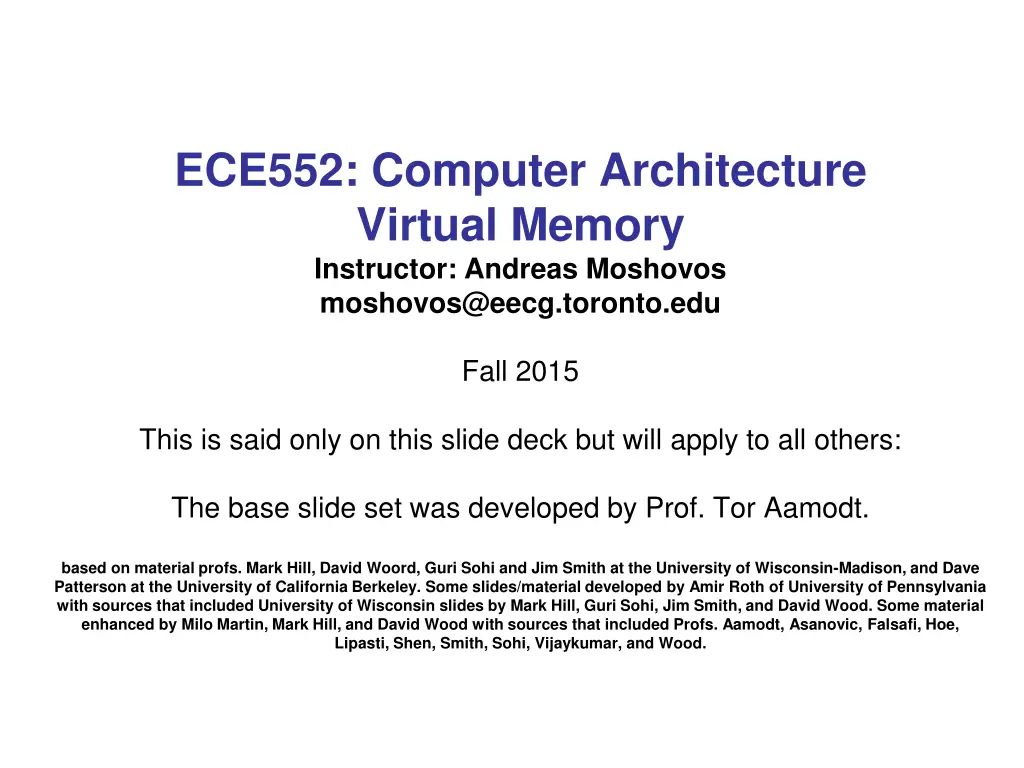
Computer Architecture Virtual Memory Overview
Explore the concepts of multitasking, memory management, and virtual memory in computer architecture. Learn how multiple programs utilize memory resources and how virtual memory systems handle memory allocation for efficient operation. Dive into the mechanisms that govern program memory usage and how software applications interact with main memory. Discover the complexities of memory allocation when running multiple applications simultaneously.
Uploaded on | 0 Views
Download Presentation

Please find below an Image/Link to download the presentation.
The content on the website is provided AS IS for your information and personal use only. It may not be sold, licensed, or shared on other websites without obtaining consent from the author. If you encounter any issues during the download, it is possible that the publisher has removed the file from their server.
You are allowed to download the files provided on this website for personal or commercial use, subject to the condition that they are used lawfully. All files are the property of their respective owners.
The content on the website is provided AS IS for your information and personal use only. It may not be sold, licensed, or shared on other websites without obtaining consent from the author.
E N D
Presentation Transcript
ECE552: Computer Architecture Virtual Memory Instructor: Andreas Moshovos moshovos@eecg.toronto.edu Fall 2015 This is said only on this slide deck but will apply to all others: The base slide set was developed by Prof. Tor Aamodt. based on material profs. Mark Hill, David Woord, Guri Sohi and Jim Smith at the University of Wisconsin-Madison, and Dave Patterson at the University of California Berkeley. Some slides/material developed by Amir Roth of University of Pennsylvania with sources that included University of Wisconsin slides by Mark Hill, Guri Sohi, Jim Smith, and David Wood. Some material enhanced by Milo Martin, Mark Hill, and David Wood with sources that included Profs. Aamodt, Asanovic, Falsafi, Hoe, Lipasti, Shen, Smith, Sohi, Vijaykumar, and Wood.
Multitasking A B A B time
Multitasking (reference) Most OS s multitask Run Program A and B at the same time Most CPUs must support multitasking Not run at exactly the same time: Run Program A for 20ms Run Program B for 20ms Run Program A for 20ms, etc NOTE: Multitasking is different than hardware multithreading . Hardware multithreading means hardware can run instructions from two or more threads at exactly the same time. Multitasking involves providing short time slices to programs (so at any time only instructions from one thread are running if the hardware is single threaded). 3
Multiple Programs Using Memory My laptop has 8GB MB DRAM Memory Usage when creating this slide: Chrome 800 MB Powerpoint 147 MB Firefox 441 MB Windows 200 MB Others: 3.7 GB Total: 4.2GB Luckily all fit in memory 4
Virtual Memory Main Memory Chrome
Virtual Memory Chrome Main Memory Firefox
Virtual Memory Chrome Main Memory Powerpoint Firefox
Virtual Memory Chrome Main Memory Application X Powerpoint Firefox Windows Calculator
Virtual Memory Chrome Main Memory Application X Powerpoint How do they all agree which portion of memory to use? What if I ran another app and the total exceeds main memory? Firefox Windows What if I open one more tab in chrome? Calculator
Mine and Yours & Devices Application A NIOS II Memory Application C Application B Disk Isolation: A process cannot access the values of another process
What an Application Sees Virtual Memory Actual Memory Application A F() Physical Memory = Actual Memory
How is it done? Virtual Physical Page: aligned, continuous 2^n sized Physical PAGE Typical sizes 4K 8K today A Assume: Fixed at design time Reality: adjustable, few sizes let s first understand w/ fixed size Virtual PAGE
Two Apps Physical Virtual Virtual B A
How are pages mapped? Who keeps the arrows? Virtual Physical Physical PAGE VPN OFF A Page Table Virtual PAGE PPN OFF
Virtual Memory (reference) Program Viewpoint Addresses start at 0 Malloc() gives program contiguous memory (consecutive addresses) Malloc(), Free(), Malloc(), Free() Can malloc() re-use parts that are freed? Causes internal fragmentation within one program There is lots of free memory available CPU/OS Viewpoint Keep all programs separate Don t all start at 0 Security implications . programs should not read each other s data! Dynamic program behavior cause memory fragmentation Starting & ending programs, swapping to disk Causes external fragmentation between programs Limited memory available Use Disk to hold extra data Use Main Memory like a cache for the program data stored on disk New structure: Page Table 23
Page Table Entries VPN OFF PPN v Page Table V = valid PPN = Physical Page Number VPN = Virtual Page Number PPN OFF
Page Table Entries VPN OFF PPN v Page Table MIPS I 4GB address space with 4KB pages OFF = 12 bits VPN = 32 12 = 20 PPN = 20 PPN OFF Physical memory could be larger or smaller More on this later on
Address Translation Page Size: 2^12 = 4096 bytes Virtual address 31 30 29 28 27 15 14 13 12 11 10 9 8 3 2 1 0 Virtual page number Page offset Table Lookup Translation 29 28 27 15 14 13 12 11 10 9 8 3 2 1 0 Physical page number Page offset Physical address 26
Page Table Translation Structure Page Table Register Virtual Address Size of Page Table? 31 30 29 28 27 15 14 13 12 11 10 9 8 3 2 1 0 Virtual Page Number Page Offset 20 12 Valid Physical Page Number 2^20 or ~1 million entries Page Table 1 Page Table Per Program 18 If 0 then page is on disk 29 28 27 15 14 13 12 11 10 9 8 3 2 1 0 Physical Page Number Page Offset Physical Address 27
Address Translation Example LW $2, 0($4) read from addr 0x10004123 VPN = 0x1000 4, Page_offset = 0x123 Access: PageTable[VPN] get PPN PageTable[0x10004] 0xFA00 2 (example) PA = 0xFA00 2123
Permissions VPN OFF PPN perm v Page Table Perm = permissions Read, Write, Execute V = valid PPN = Physical Page Number VPN = Virtual Page Number PPN OFF
Page Table (reference) Holds virtual-to-physical address translations Access like a memory Input: Virtual Address Only need Virtual PageNumber portion (upper bits) Lower bits are PageOffset, ie which byte inside the page Output: Physical Address Lookup gives a Physical PageNumber Combine with PageOffset to form entire Physical Address Where to hold the PageTable for a program? Dedicated memory inside CPU? Too big! not done! Instead, store it in main memory 30
How are Virtual Pages Mapped? A attempts to access 0x1000, VPN = 0x1 Physical PAGE A VPN OFF Virtual Page PT PPN OFF OS
How are Virtual Pages Mapped? PT[0x1] = not valid, Translation finds an invalid entry Physical PAGE A VPN OFF Virtual Page PT PPN OFF OS
How are Virtual Pages Mapped? PAGE FAULT: Interrupt to OS, PC = Handler Physical PAGE A VPN OFF Virtual Page PT PPN OFF OS
How are Virtual Pages Mapped? OS finds an empty page and allocates PT[0x1] entry Physical PAGE A VPN OFF Virtual Page PT PPN OFF OS
How are Virtual Pages Mapped? Page Fault return and application retries fetch from 0x1000 Physical PAGE A VPN OFF Virtual Page PT PPN OFF OS
How are Virtual Pages Mapped? Application tries to do a load from another page Physical PAGE A VPN OFF Virtual Page PT PPN OFF OS
How are Virtual Pages Mapped? Page Fault, OS allocates, return and retry Physical PAGE A VPN OFF Virtual Page PT PPN OFF OS
Where is the Page Table? Page Table is in memory: 32 b Address space 2^20 = 1M entries One page table per process Virtual Physical Physical PAGE VPN OFF A PT PPN OFF Virtual PAGE OS
Who accesses the page table? NIOS II does: ldw r8, 0(r10) This is in virtual memory Has to be translated to a physical address first Must access the PT But the PT is in memory Must do another load Who does that? Isn t this slow? Every Virtual Memory Access becomes two accesses Page Translation Actual Access
Page Table Implications CPU executes Load instruction Recall: address is now a Virtual Address First step: Lookup address translation Where is page table? In main memory Special CPU register called Page Table Register (PTR) Holds starting address of page table Read DataMem from PTR+PageNumber to get Physical Address Second step: Access the data Read DataMem from Physical Address Every load/store requires TWO memory accesses Slow Can we speed up the translation step? Yes, use a cache
Translation Lookaside Buffer Cache of Page Table Entries VPN OFFSET VPN PPN perm v VPN PPN perm v VPN PPN perm v perm PPN OFFSET
TLB: Translation Looksaside Buffer (A special cache for the Page Table) Physical Page Number Virtual page number V Tag TLB 1 1 1 1 0 1 Physical Memory Physical Page Number or Disk Address V 1 1 1 1 0 1 1 0 1 1 0 1 Disk Page Table 43
Combined TLB & Cache Structure Virtual address 31 30 29 15 14 13 12 11 10 9 8 3 2 1 0 Virtual page number Page offset 20 12 Valid Dirty Physical page number Tag TLB 1. TLB lookup TLB hit 20 2. Convert VA to PA Physical page number Page offset Physical address Byte offset set Physical address tag Cache index 14 2 16 3. Access data cache Tag Data Valid Cache 32 Data Cache hit 44
TLB Operation Like a Cache Processor does reads OS does writes Initially Empty On Page Fault cache PT entry When full evict TLB entry On Hit no need to access PT On Miss access PT Software (e.g., SPARC) or hardware (x86) OS manages the TLB
TLB Typical Organization 32-128 Fully Associative L1 TLB 256-1024 2- to 8-way Set-Associative L2 TLB
Superpages Framebuffer 1920 x 1200 x 3 bytes ~ 6.6 Mbytes Accessed frequently Refresh rate say 100Hz Every pixel (3 bytes) accessed times a second But there are millions of pixels With 4K pages 1688 pages OS can support large pages to avoid allocating multiple entries
Paging to Secondary Storage Not all pages need to stay resident Think of many apps running Think of one app that needs 4G but system has only 2G SWAP file : evict pages from physical memory to disk Page table extended to keep track of both
Permissions? Read/Write/Execute Devices? Cacheable / Non-Cacheable Can we swapped? Pageable vs. Non-Pageable Lock pages in memory OS, performance
How it all works? Part of Memory Space Belongs to OS Application cannot touch Special Call Instructions System Calls OS
How it all works? OS Maintains Free list of pages Page Table per Process OS
Multi-Level Page Tables Usually Processes are like this Page Table A In use in use Lots of Empty
Multilevel Page Tables VPN offset L1 idx L2 idx Where in memory is the L2 table (address, valid) Page Table Actual Translation In use L2 Tables in use PPN offset
Multi-Level Page Table Example 4GB address space, 4K pages 1M pages VPN = PPN = 20 bits Flat PT: 1M entries, all allocated 2-level PT with 2K fist level (2^11) 1st level 2K entries 2K 2nd level tables Each with 512 entries (20 (VPN) 11 (1st level index))
Page tables may not fit in memory! A table for 4KB pages for a 32-bit address space has 1M entries Each process needs its own address space! Two-level Page Tables 32 bit virtual address 31 22 21 12 11 0 P1 index P2 index Page Offset Top-level table wired in main memory Subset of 1024 second-level tables in main memory; rest are on disk or unallocated 58
Combined TLB & Cache Structure Virtual address 31 30 29 15 14 13 12 11 10 9 8 3 2 1 0 Virtual page number Page offset 20 12 Valid Dirty Physical page number Tag TLB 1. TLB lookup TLB hit 20 2. Convert VA to PA Physical page number Page offset Physical address Byte offset set Physical address tag Cache index 14 2 16 3. Access data cache Tag Data Valid Cache NOTE: TLB is now slowing our cache 32 Data Cache hit 59
6th Cache Optimization: Fast hits by Avoiding Address Translation CPU CPU CPU VA VA VA VA Tags PA Tags $ TB $ TB VA PA PA L2 $ TB $ MEM PA PA MEM MEM Overlap $ access with VA translation: requires $ index to remain invariant across translation Naive Organization Virtually Addressed Cache?
Use virtual addresses for cache? CPU VA VA Tags $ VA TB PA MEM Virtual Addresses Physical Addresses A0-A31 Physical Virtual A0-A31 Virtual Translation Look-Aside Buffer (TLB) CPU Cache D0-D31 Main Memory D0-D31 D0-D31 Only use TLB on a cache miss
Problems: VA indexed VA tagged What happens on a context switch? Process 1: VA 0x0 PA 0x100 Process 2: VA 0x0 PA 0x200 Same VA from different processors pointing to difference Pas. What if P1 accesses VA 0x0 and then we context switch to P2? What will P2 read if it accesses VA 0x0? Solution? #1: Flush the cache What about a multiprocessor? Coherence? #2: Add ASID: address space identifier (which processes is running) Any problems with this?





